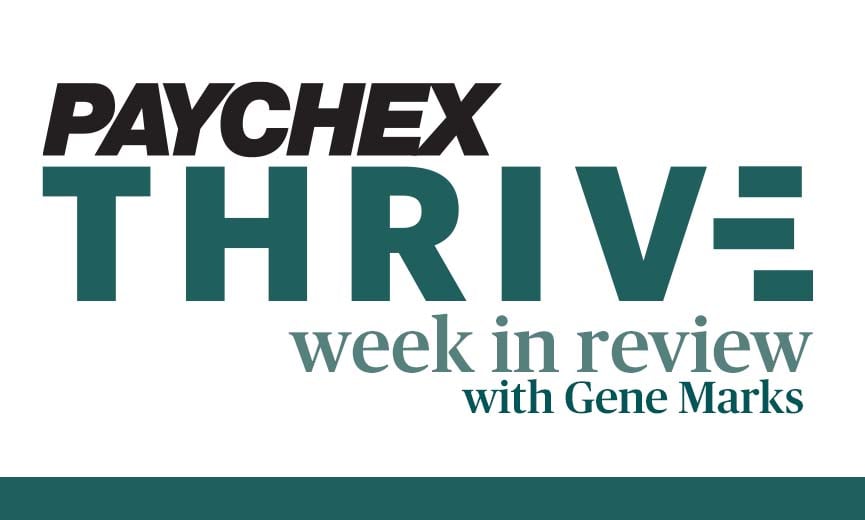Vigilancia del empleo en la pequeña empresa, otras fuentes: hay empleos, pero no candidatos cualificados

Podcast •

Vea
Resumen
Job growth is slowing, according to Paychex, the U.S. government, and the National Federation of Independent Businesses. There are many jobs available, although the Wall Street Journal reports most of those are in the government or in an industry sector with government involvement. Even solid hiring plans aren’t making a difference because what is lacking is the applicants – or at least qualified ones. Gene Marks shares his thoughts and insights on why part-time workers are trending. Watch or listen to the podcast.
Ver transcripción
Hey, everybody, it’s Gene Marks and Welcome back to another episode of the Paychex THRIVE Week in Review podcast. This is the podcast where we take a few items in the news that impacts your business and mine and we talk a little bit about the impact of it on our companies. So, let's get to it.
This week, it's all about jobs, jobs, jobs.
The federal government released their unemployment numbers and jobs numbers last Friday. I'm going to get back to that in a minute. First, let's talk about Paychex. Paychex released their monthly Small Business Employment Watch last week, and according to the Small Business Employment Watch, U.S. employers with fewer than 50 employees continue to add jobs in June, although at a slower pace than in May.
Hourly earnings growth for small business workers held steady at 3.16% in June. Now, remember, that's about at the rate of inflation, as well. So, hourly earnings are keeping up with inflation, but not any higher than that.
According to John Gibson, Paychex’s CEO, “Small business continues to add jobs across the country in June, and there was little change in wage inflation, which reflects relative stability for small businesses. The trends in our wage data,” he says, “for the first half of 2024, are also signaling steady hourly earnings growth heading into the second half of the year.”
A couple other comments from Gibson. “While jobs are growing nationally, small businesses in some geographies and industries continue to face a challenging operating environment due to complex regulations, a tight labor market, and inflation generally pressures. We are continuing to see the impact of these challenges in the West region, particularly in the state of California, which came in last among states for job growth in June.”
“At the same time,” Gibson says, “our customers are telling us they are being more selective in the hiring process and searching for candidates who will boost their culture and bottom line.”
Let's switch over to the National Federation of Independent Businesses. They released their jobs report last week, as well, and the NFIB found solid employment hiring plans among business owners, but overall unsuccessful attempts to hire additional workers. A seasonally adjusted 37% of all the small businesses that they surveyed reported job openings they could not fill in their current period. That's down five points from May. A seasonally adjusted 15% of owners plan to create new jobs in the next three months, unchanged from May. Overall, 60% of owners reported hiring or trying to hire in late June. Of those hiring or trying to hire, 85% reported few or no qualified applicants for the positions they were trying to fill. Thirty-one (31%) of owners reported fewer qualified applicants for their open positions and 20% reported none.
So, we see on the Paychex side that, you know, hiring still remains pretty strong and your wages are staying you know, are staying strong and a 3% annual rate. But the NFIB is also saying they all know hiring plans continue to remain consistent, hiring plans are also having challenges among a lot of businesses because they can't find good applicants.
So, what does that mean? Well, there's a report in CNN this past week about part-time workers. It says that companies are becoming fonder of part time workers these days. Here's what CNN says: “Demand for full-time workers on job sites indeed, has been flat from January 22 to May of this year,” according to a recent analysis of millions of job postings. “But advertisements for part-time gigs are up about 10% over the same period. Postings for those kinds of jobs took off in 2022 and have remained near those elevated levels ever since.”
So, while Labor remains tight and hiring plans do remain strong, it appears a lot of businesses are now turning to try and find those workers through part-time jobs. We continue to have that labor issue.
Finally, the U.S. government released their job numbers overall last week, and the Wall Street Journal had some thoughts on it, and I thought I would share with you, as well. The Journal's editorial team reported that U.S. employers added 206,000 jobs, even though the unemployment rate just ticked up a tiny bit. It is still – we have the labor force participation rate right now is at its strongest that it's been in the past 20 years.
However, on the other hand, the Wall Street Journal's piece says the jobs market appears to be slowing. New jobs were revised down by a combined 110,000 from May and April. Job growth has averaged about 177,000 these past months, compared to 220,000 for the past year. And the Wall Street Journal is reporting that most of these new jobs, about 90% of them, were found in government, health care, and social assistance. All of these relying on federal type of work being involved.
Manufacturing employment, they say, has been flat since last November. IT jobs have been shed over the past two years and job growth in leisure and hospitality has slowed to a trickle, they say. So, although jobs are being added, the job market remains pretty strong. The Wall Street Journal saying most of those jobs are being added by the government or government-funded facilities.
On the small business side, Paychex is saying that employers continue to add jobs, but just like the NFIB reports, they are having a hard time finding good workers. And as I've just reported you from CNN, it seems that a lot of employers are turning to part-time workers to try and fill those gaps.
So, jobs, jobs, jobs. The bottom line is this the job market is still extremely competitive. It is still very difficult to find good employees and good talent. It is very, very important for all of us as business owners to make our case. Obviously, we can add compensation and good benefits. It's very tough to compete with larger companies, but working for smaller businesses has a lot of advantages, a lot of flexibility, a lot of chance to make a big difference, a lot of opportunities to, you know, be really involved with the owners of a company, and those are the kind of things that we should be stressing as business owners and what is a very tight and continuing to be tight job market.
That's the news for this week. You have been watching and or listening to the Paychex THRIVE Week in Review. My name is Gene Marks. If you'd like some tips or help in running your business, you’d like to see prior episodes of this podcast, please sign up for our Paychex THRIVE newsletter. Go to paychex.com/thrive and you can sign up there. I will be back with you in another week with news that happened during that week that impacts your business.
Again, my name is Gene Marks. Thanks for watching and listening. We'll see you soon.
This podcast is property of Paychex, Incorporated, 2024. All rights reserved.

 Apple Podcast
Apple Podcast Spotify
Spotify iHeartRadio
iHeartRadio








